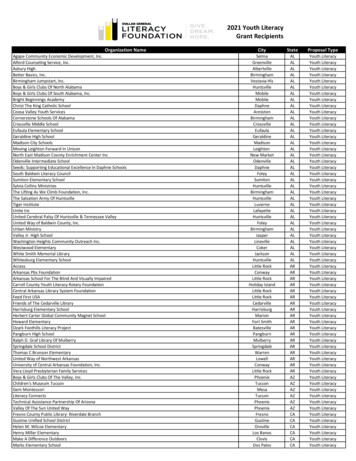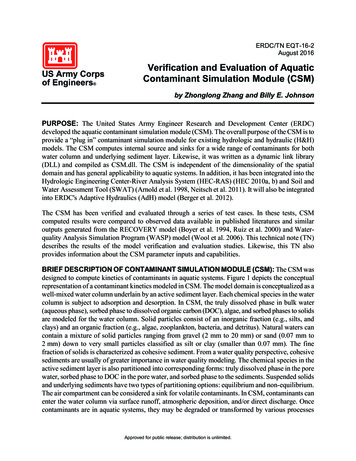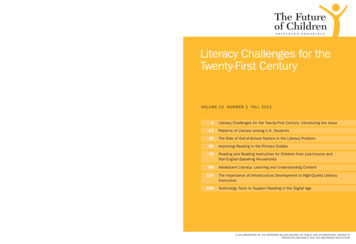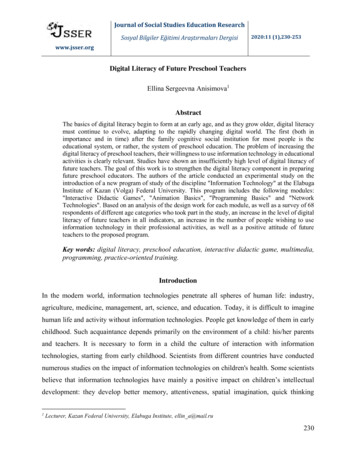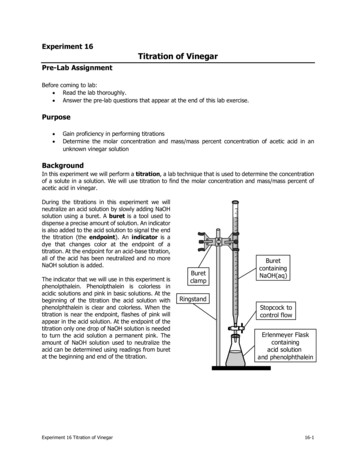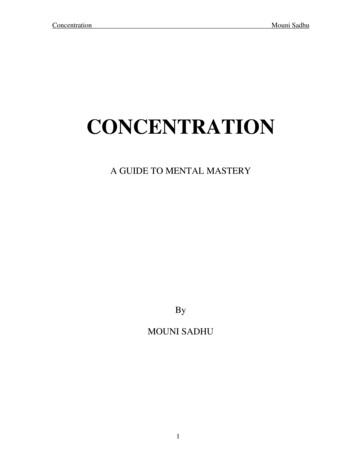
Transcription
CONCENTRATIONSBecause of a demonstrated need for support in literacy, special education, and Teaching English as aSecond Language (TESL) in urban schools, we aim to offer students in the 5-year Master’s of Arts inTeaching in Urban Secondary Education a choice in a concentration based on their interests. Additionally,we have received student inquiries in each of these concentration areas and urban school administratorshave noted a need for candidates with these skills. Students selecting TESL would graduate with acertificate in ESL and/or Bilingual and students selecting a concentration in Literacy or Special Educationwould have this designation on their transcripts and could potentially transfer the Masters credits fromtheir concentrations to a future Masters degree in that concentration area. Additionally, students in thespecial education concentration can apply their special education courses toward a Post-BaccalaureateCertificate. These concentrations will utilize existing courses within the Special Education, Language,and Literacy (SELL) department at TCNJ. In addition to courses required for all students as part of theSecondary Urban Education program sequence, students selecting the Literacy or Special Educationoption would be required to complete four additional courses in their concentration while studentsselecting the ESL concentration would take five additional courses to meet ESL/Bilingual certificationrequirements.Literacy Concentration (4 courses):1.RDLG 579: Content Area Literacy: This course examines the purposes, specialized readingskills, reading materials, and modes of inquiry specific to the content areas; application of thesespecialized skills to the specific reading task. (Fall, Spring, Summer)2.RDLG 684 – Digital Literacies in a Globally Connected World: This graduate course isdesigned to explore how literacy and learning are changing as people participate with digitaltechnologies across intersecting local and global networks. We will collaboratively investigatehow young people's digital literacies-their culturally and socially situated meaning makingpractices mediated by digital tools-emerge in relation to constantly shifting technologies ofcommunication. Further we will look at how these digital literacies are constructed,reconstructed, negotiated, and embodied in multiple semiotic systems across everyday contexts.This course highlights how digital literacies are situated, and how these socio-culturalunderstandings illuminate issues of power and privilege. (Summer Only)3. RDLG 673: The Writing Process in Literacy: The purpose of this course is to provide studentswith an in depth examination of current research and methods used in reading, writing andlanguage arts instruction. It explores theories of how to teach the writing process and examinesthe connection between reading and writing performance in literacy development. This coursealso explores and examines skills that support writing processes and identifies effective strategiesfor cross-curricular integration of creative and informational writing. (Spring - Blended Course)
4. ESLM 555: The Intersections of Culture, Language and (dis)AbilitiesEnglish Learners (ELs) bring several challenges to the classroom. Those challenges can cause agreat deal of confusion for teachers in their attempt to understand whether they are due to thelearner’s lack of proficiency in English or to a disability. The purpose of this course is to provideparticipants with essential tools to separate a language difficulty from a learning disability. Itaims to engage participants in inquiry and reflection on how culture, language, and (dis)abilitiesintersect and how those intersections can affect teachers’ interactive, instructional and assessmentpractices of ELs’ classroom experiences. The course aims to deconstruct deficit thinking towardELs and their potential to learn. It provides a framework for participants to align theirpedagogical expectations and instructional approaches to ELs’ diverse levels of Englishproficiency to increase these learners’ opportunities to learn. The course discusses issues relatedto the disproportionality of ELs in special education programs and presents recommendations foran effective referral process if a disability needs to be addressed. The course highlights essentialcomponents of high quality instruction for ELs, appropriate and reliable assessment strategies toevaluate their academic progress over time, and key components of effective culturally sensitivepedagogy through assignments that capitalize on inquiry, reflection, observation, and professionaldevelopment. (Spring)[TAKE RDLG 571 AS A FALL COURSE IF YOU WANT A FALL COURSE IN YOUR 4THYEAR. This would replace ESLM 555. NOTE: THIS IS NOT REQUIRED]RDLG 571: Language and the Teaching of Reading: This course examines the place of language inculture; linguistics and psycholinguistics as academic disciplines; examination of concepts significant forthe reading program; analysis of American English; implications of cultural, linguistic, andpsycholinguistic data for instructional practice and for selection of instructional materials. (Fall)]
Special Education Concentration (4 courses):* Counts toward special education certification Can be used as an elective toward special education certification1. *EDUC 513: Collaboration: This course is based on the premise that successful teachers arethose who communicate effectively with other teachers in their schools, related servicesprofessionals in their district, parents of their students, and personnel in community agencies.Specific collaboration and team problem-solving skills are taught through the case method, roleplaying, and field-based projects. Emphasized are family-centered, culturally sensitive practicesand collaborative problem solving. (Fall, Spring, Summer)2. *EDUC 614: Creating/Sustaining Classroom Communities: Behavior issues are reported bynew teachers to be one of the biggest challenges they encounter. Current literature indicates thatfor many students, traditional reactive approaches are ineffective and may indeed exacerbateinappropriate behaviors over the long run. The purpose of this course is to help future teachersdevelop a critical awareness of their classroom as a community and through this awarenessdevelop strategies to proactively address behavioral challenges within this community. Thecourse encourages students to develop a position of inquiry towards behavior that is reflective,proactive, and non-aversive. The course draws extensively on literature and best practices in areassuch as constructivist approaches to classroom management, positive behavioral supports, personcentered planning, parent-professional collaboration, and social skills training. (Spring, Summer)3. ESLM 555: The Intersections of Culture, Language and (dis)AbilitiesEnglish Learners (ELs) bring several challenges to the classroom. Those challenges can cause agreat deal of confusion for teachers in their attempt to understand whether they are due to thelearner’s lack of proficiency in English or to a disability. The purpose of this course is to provideparticipants with essential tools to separate a language difficulty from a learning disability. Itaims to engage participants in inquiry and reflection on how culture, language, and (dis)abilitiesintersect and how those intersections can affect teachers’ interactive, instructional and assessmentpractices of ELs’ classroom experiences. The course aims to deconstruct deficit thinking towardELs and their potential to learn. It provides a framework for participants to align theirpedagogical expectations and instructional approaches to ELs’ diverse levels of Englishproficiency to increase these learners’ opportunities to learn.The course discusses issues related to the disproportionality of ELs in special education programsand presents recommendations for an effective referral process if a disability needs to beaddressed. The course highlights essential components of high quality instruction for ELs,appropriate and reliable assessment strategies to evaluate their academic progress over time, andkey components of effective culturally sensitive pedagogy through assignments that capitalize oninquiry, reflection, observation, and professional development.(Spring)
4. (If offered in Spring) SPED 655: Advanced Topics in the Social and Cultural Constructionof Behavior: This course introduces students to how constructs of good/bad behavior are situatedwithin larger systems of structural inequality, privilege and oppression. Employing criticaldisability studies perspectives and principles of social justice, the course encourages students toresist deficit-based narratives of such children and families and focus on the possibilities thatexist within supportive contexts. This course approaches emotional and behavioral disorders associal, cultural, and historical constructs and in doing so examines the ways in which educationalpolicy, social systems and schooling practices set the stage for the construction of this disabilitylabel. Students will use first-person narratives to investigate the intersections of poverty,language, ability, race, gender, sexual orientation, nationality and ethnicity as they relate tobehavior. Typical disciplinary practices and their historical roots will be examined as wellassessment practices that culminate in the construction of EBD. The course introduces students toalternative constructions of behavior and the principles of democratic citizenship and socialresponsibility with an emphasis on local issues in Ewing, Trenton and the State of NewJersey. An appreciation of human neurodiversity and a presumption competence are integralvalues that run through the strand. (Fall)ORSPED 626: Teaching Students with Severe DisabilitiesAn advanced course about teaching students with moderate to severe mental retardation and othersevere disabilities, this course focuses on meeting the special needs of this low-incidencepopulation. Emphasis is placed on current philosophies and services such as preparing studentsto live and work in the community, self-advocacy, family-centered practices, appropriateapplications of assistive technology, and designing functional curriculum plans. (Spring)ORSPED 631: Transition and Community Based InstructionThis course introduces students to the historical, philosophical and legal foundations of transitionand vocational education in public schools. Based upon a review of the current literature in thisarea, this course identifies research-validated practices and issues in the transition of youth withdisabilities from high school to adult living. Contemporary issues including the legalresponsibilities of schools and educators; person centered planning; functional vocationalassessment; and collaboration with families and community agencies are addressed. It is expectedthat by the end of this course, students will have an understanding of the development oftransition services as well as the methods of assessment and instruction for learners with diverseabilities in a variety of community settings. (Spring)
TESL Concentration & Certification (See Sequence TABLE Below):SemesterFall of 4th YSpring of 4th YSummerFall- of 5th YSpring of 5th YNon-Math MajorESLM 577ESLM 587ESLM 578ESLM 579Clinical IIESLM 545ESLM 525Math MajorESLM 545ESLM 577Clinical IIESLM 525ESLM 579ESLM 578ESLM 587ESLM 525: Second Language Acquisition: An overview of some of the major themes and issues insecond language acquisition and how this impacts learning in an academic setting. Consideration will begiven to topics such as research methodology, the role of the native language, morpheme acquisitionorders, differential success, the linguistic environment, theories of second language acquisition, etc.(Spring, Summer-Thailand or Spain)ESLM 545: English Structure and Proficiency Assessment: This course is designed to developstudents' competency in the applied linguistics with a good understanding of English structure and itsapplication in L2 learning and acquisition. It enables students to compare the structures of phonetics andgrammar of English and L2 learners' L1, to discover or identify the pitfalls and potential trouble spots invarious areas of phonetics and grammar during L2 learners' learning process, and design appropriate andeffective strategies for L2 learning and instruction. This course also provides students with languageproficiency assessment standards, instruments, and strategies. (Spring, Summer – Thailand or Spain)ESLM 577: Sociolinguistics and Cultural Foundations of Second Language EducationThis course examines how sociolinguistics emerged as a subfield of linguistics, i.e., taking a functionalistapproach to the study of language. We address issues such as what linguistic knowledge is knowledge of;what a native speaker knows about his/her language; and what it takes to be a communicativelycompetent speaker. Among the topics that are covered are: global Englishes, English as a lingua franca,language variation, speech act theory, and pragmatics. The course also includes an introduction toconversation analysis (CA) given that language is a primordial site of human sociality. In particular, weexplore the notion of interactional competence from a CA perspective. And we aim to connect insightsand findings drawn from CA with issues and concerns in second language pedagogy. (Fall, Summer –Thailand or Spain)ESLM 578: Theory and Practice in ESL: Designed to develop competency in the theoreticalfoundations of second language acquisition, an understanding of the unique aspects of the process ofsecond language teaching, and the necessary practical application of those theories as required in the ESLclassroom. (Fall, Summer-Thailand or Spain)
ESLM 579: Language and Literacy for ESL: This course provides an overview of issues in languageand literacy as they relate to the teaching of English as a second language. Theories and models of firstand second language reading processes are discussed, which provide a basis upon which to considerreading and literacy skills development and acquisition in the second language context. Among the topicsthat we address are: linguistic processing of text (i.e., phonological, morphological, syntactic, andsemantic cueing in L1 and L2), strategies and metacognitive skills, content schema and backgroundknowledge, vocabulary acquisition, reading and writing relationships, and theories and issues in secondlanguage reading. (Fall, Spring, Summer – Thailand or Spain)ESLM 587: Curriculum & Methods/Multilingual Population: This course is designed to developcompetence in the application of the theoretical foundations of second language learning and acquisitionand bilingual education in teaching multilingual populations. It enables candidates to practice ESL and/orbilingual methodologies, to design and implement appropriate instructional strategies and activities, todevelop curricula and select material, and to perform proper evaluation procedures for ESL and bilingualprograms respectively. (Spring, Summer – Thailand or Spain)
their concentrations to a future Masters degree in that concentration area. Additionally, students in the special education concentration can apply their special education courses toward a Post -Baccalaureate Certificate. These concentrations will utilize existing courses within the Special Education, Language, and Literacy (SELL) department at .


